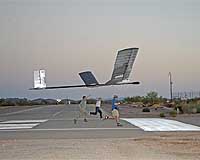 |
College Park MD (SPX) Aug 06, 2010 Call it the anti-sunscreen. That's more or less the description of what many solar energy researchers would like to find - light-catching substances that could be added to photovoltaic materials in order to convert more of the sun's energy into carbon-free electricity. Research reported in the journal Applied Physics Letters, published by the American Institute of Physics (AIP), describes how solar power could potentially be harvested by using oxide materials that contain the element selenium. A team at the Lawrence Berkeley National Laboratory in Berkeley, California, embedded selenium in zinc oxide, a relatively inexpensive material that could be promising for solar power conversion if it could make more efficient use of the sun's energy. The team found that even a relatively small amount of selenium, just 9 percent of the mostly zinc-oxide base, dramatically boosted the material's efficiency in absorbing light. "Researchers are exploring ways to make solar cells both less expensive and more efficient; this result potentially addresses both of those needs," says author Marie Mayer, a fourth-year University of California, Berkeley doctoral student based out of LBNL's Solar Materials Energy Research Group, which is working on novel materials for sustainable clean-energy sources. Mayer says that photoelectrochemical water splitting, using energy from the sun to cleave water into hydrogen and oxygen gases, could potentially be the most exciting future application for her work. Harnessing this reaction is key to the eventual production of zero-emission hydrogen powered vehicles, which hypothetically will run only on water and sunlight. Like most researchers, Mayer isn't predicting hydrogen cars on the roads in any meaningful numbers soon. Still, the great thing about solar power, she says, is that "if you can dream it, someone is trying to research it."
Share This Article With Planet Earth
Related Links American Institute of Physics All About Solar Energy at SolarDaily.com
 Lithium-Sulfur Batteries Power World Record Flight
Lithium-Sulfur Batteries Power World Record FlightTucson AZ (SPX) Aug 05, 2010 Sion Power has announced that their proprietary lithium sulfur (Li-S) batteries played a critical role in the QinetiQ Zephyr smashing the world record for the longest duration unmanned flight. A result of an intensive joint development effort between Sion Power and QinetiQ, the Zephyr flight exceeded 336 hours (14 days) of continuous flight, significantly surpassing the previous official r ... read more |
|
| The content herein, unless otherwise known to be public domain, are Copyright 1995-2010 - SpaceDaily. AFP and UPI Wire Stories are copyright Agence France-Presse and United Press International. ESA Portal Reports are copyright European Space Agency. All NASA sourced material is public domain. Additional copyrights may apply in whole or part to other bona fide parties. Advertising does not imply endorsement,agreement or approval of any opinions, statements or information provided by SpaceDaily on any Web page published or hosted by SpaceDaily. Privacy Statement |